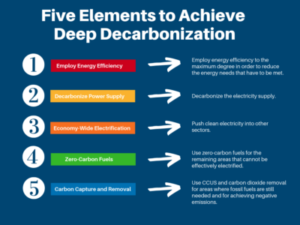The burning of municipal waste seems to be included as a qualifying source of “clean energy” in a recent House proposal to transition the United States to a sustainable, low carbon future.
A key plank of the CLEAN Future Act proposal, introduced in January by House Democrats, is achieving “net-zero emissions from the electricity sector” through the use of a Clean Energy Standard (CES), which Democrats will likely pass this year ahead of the election.
The CES would require retail electricity suppliers to obtain 100% of their electricity from “clean energy sources” by 2050. That is the right way to go.
However, according to the Environmental Protection Agency, burning municipal solid waste (MSW) emits nearly as much CO2 per unit of energy as coal—and almost twice as much as burning natural gas. This is not the way to get to net-zero.
EU Policy Excludes Waste Burning
The European Commission announced in December 2019 a new classification system to guide the growing number of private and public capital investors who want to put capital to work in ways that will not only generate strong returns, but will also have a positive environmental impact.
Democrats in the House understand that the Europeans are on to something: reducing waste and investing in low carbon development is both an ecological imperative and a roadmap for economic growth. But these lawmakers may be overlooking one important plank in the European sustainable growth plan: don’t burn garbage to make electricity.
The EU classification system tells investors what types of projects and activities should be considered “green.” To put it mildly, burning municipal solid waste (MSW) to make electricity did not make the list.
Waste incineration is included in the commission’s list of activities that could cause “significant harm to environmental objectives.” (Article 12). Two of those environmental objectives are climate change mitigation and the promotion of a “circular” economy.
The commission was likely well aware of European analyses finding that waste incineration for energy production is almost twice as carbon intensive as the EU grid average and thus works against the goal of a zero carbon grid. In Article 9, the commission lists “minimising incineration” of waste as among the activities that can make a “[s]ubstantial contribution to the circular economy.”
Burning Garbage Hurts Recycling Sector
Incentivizing the burning of our garbage also undercuts incentives for waste reduction and hurts the recycling sector—and at a very bad time. The U.S. recycling industry is in crisis. At the end of 2017, China severely restricted the import of U.S. recyclables.
Prior to that, we were exporting about a third of waste plastic for recycling to China; in 2018 that number was less than 5%. Hundreds of towns and cities across the United States have either shut down or greatly reduced their recycling programs.
The language in the House Clean Energy Standard appears to suggest that the eligible waste incineration facilities should be limited to those that use “postrecycled” waste. Given the collapsing of our recycling industry, waste truly void of recyclable materials may only exist in theory.
Even before China’s import restrictions, half of the carbon dioxide emissions from waste incineration came from plastic; today even less is being diverted. While not yet in the legislative text of the CLEAN Future Act, the authors note that other issues to be addressed include “recycling and waste management.” But any additional—and badly needed—policies to promote recycling will be hindered by the voracious appetite for fuel posed by waste-to-energy facilities.
A more sustainable and lower carbon economy means a more resilient, efficient, and equitable economy that can grow and create more wealth by mitigating the headwinds of climate change and resource constraints that are otherwise a drag on economic growth.
We need lower carbon energy; we need to reduce waste; and we need to create clean economy jobs. We do not need to burn our trash for energy.
This column does not necessarily reflect the opinion of The Bureau of National Affairs, Inc. or its owners.
Author Information
Roger Ballentine is the president of Green Strategies Inc. He served as chairman of the White House Climate Change Task Force under President Bill Clinton.
Originally published in Bloomberg Environment.

 During these discussions, the group agreed that there are five basic elements necessary to decarbonize the energy system: (1) employ energy efficiency to the maximum degree; (2) decarbonize the electricity supply; (3) electrify other sectors as much as possible, including heat, transportation, and industrial processes; (4) use zero-carbon fuels for the areas that cannot be effectively electrified; and (5) use carbon capture, utilization, and storage (CCUS) and carbon dioxide removal (CDR) for areas where fossil fuels are still needed and for achieving negative emissions.
During these discussions, the group agreed that there are five basic elements necessary to decarbonize the energy system: (1) employ energy efficiency to the maximum degree; (2) decarbonize the electricity supply; (3) electrify other sectors as much as possible, including heat, transportation, and industrial processes; (4) use zero-carbon fuels for the areas that cannot be effectively electrified; and (5) use carbon capture, utilization, and storage (CCUS) and carbon dioxide removal (CDR) for areas where fossil fuels are still needed and for achieving negative emissions.


